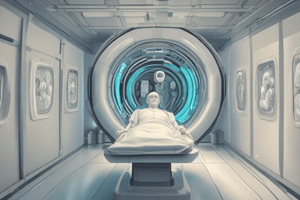Podcast
Questions and Answers
What type of radiation does a CT scan machine use?
What type of radiation does a CT scan machine use?
- X-rays (correct)
- Alpha radiation
- Ultraviolet radiation
- Gamma radiation
What is an advantage of CT scans?
What is an advantage of CT scans?
- The machine is very lightweight and portable
- The patient needs to be present during the interpretation
- The image that is produced can be selectively viewed and enlarged (correct)
- The images produced are always blurry
What is a disadvantage of CT scans?
What is a disadvantage of CT scans?
- They are very easy to interpret
- Very high-density materials produce severe artifacts (correct)
- They can only be used for facial injuries
- They are inexpensive to maintain
What type of images does a CBCT machine produce?
What type of images does a CBCT machine produce?
What is a component of a CBCT machine?
What is a component of a CBCT machine?
What is an application of CT scans?
What is an application of CT scans?
What is a feature of CT scans?
What is a feature of CT scans?
What is a limitation of CT scans?
What is a limitation of CT scans?
Flashcards are hidden until you start studying
Study Notes
Computed Tomography (CT)
- Uses X-rays, a powerful form of electromagnetic radiation
- Evaluates the entire body
- Multi-detector CT scanners have evolved, with better clinical applications
- Applications include:
- Osteomyelitis and space infections
- Midfacial and mandibular trauma
- Developmental anomalies of the craniofacial skeleton
- Benign intraosseous cysts and neoplasms of the jaws
- Benign and malignant neoplasms of the orofacial soft tissues
- Soft-tissue cysts
- Advantages:
- Provides axial, coronal, and sagittal views of tissue
- Displays anatomically precise location of lesions and extent
- Shows normal and pathological soft tissue structures clearly
- Allows for selective viewing and enlargement of areas of interest
- Images can be manipulated and stored for later viewing
- Disadvantages:
- Sophisticated and expensive to maintain
- High-density materials produce severe artifacts, making interpretation difficult
- Inherent risk associated with contrast medium
Cone-Beam Computed Tomography (CBCT)
- A new medical imaging technique that generates 3D images
- Based on a cone-shaped X-ray beam centered on a 2D detector
- Components:
- X-ray source with a rotating gantry
- Divergent pyramidal or cone-shaped source of ionizing radiation
- 2D X-ray detector on the opposite side
- Advantages:
- Rapid scan time
- Beam limitation
- Image accuracy
- Reduced patient radiation dose
- Interactive display modes applicable to maxillofacial imaging
- Disadvantages:
- Extinction artifacts
- Beam hardening artifacts
Studying That Suits You
Use AI to generate personalized quizzes and flashcards to suit your learning preferences.




